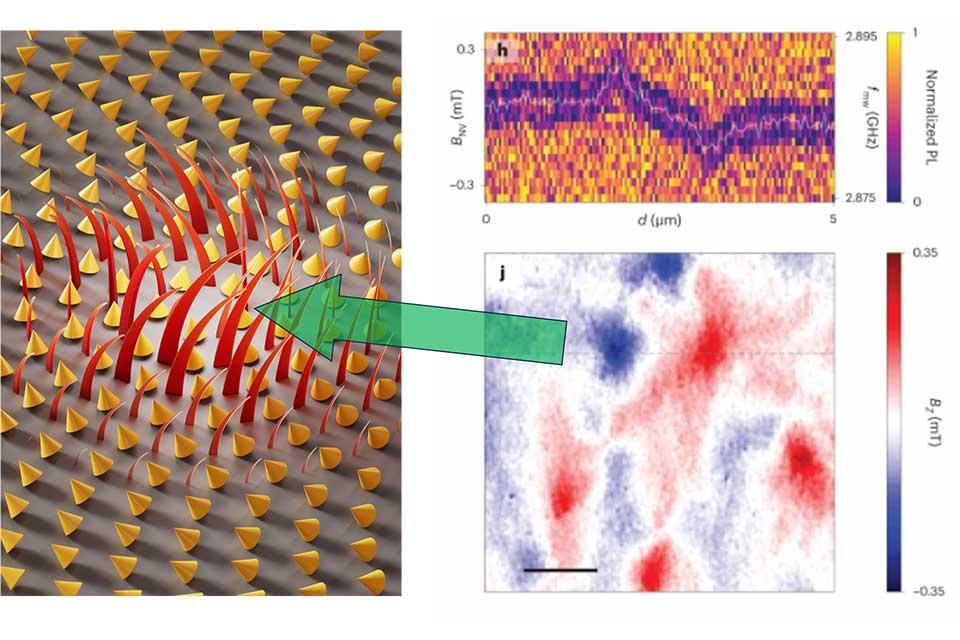Researchers have discovered a new class of emergent magnetic monopoles in the quantum material known as hematite – the main component of rust. These elusive emergent particles could pave the way to greener and more powerful computing technologies.
Researchers from the University of Oxford, in collaboration with the University of Cambridge and the National University of Singapore, used a diamond quantum sensor and detected faint magnetic signals above the surface of antiferromagnetic hematite to observe this unexpected phenomenon.
‘According to Maxwell’s equations, magnetic objects, whether we’re talking about fridge magnets or the Earth itself, must always exist as a pair of magnetic poles, and they cannot be isolated,’ said Professor Mete Atatüre from the University of Cambridge, who led the research. The magnets used every day have two poles: north and south. However, in the 19th century, some physicists hypothesised that monopoles could exist, but in one of his foundational equations for the study of electromagnetism, James Clerk Maxwell disagreed. ‘If monopoles did exist, and we were able to isolate them, it would be like finding a missing puzzle piece assumed lost,’ continues Professor Atatüre. The first suggestion on how monopoles could exist in a material was around 15 years ago, and it relied on the separation of north and south poles such that locally each pole appears isolated in a special materials class called spin ice; while the physics holds, the monopole behaviour had not been observed, but rather inferred.
The concept of emergence, popularised by Nobel Laureate Philip Anderson’s essay “More is different” [1], allows an alternative strategy to pursue monopoles. The central idea is the combination of many physical entities can give rise to emergent properties that are more than the sum of its parts. The collaboration has now uncovered monopoles spread over two-dimensional space like hockey pucks of magnetic charges. Adding to the excitement, these charges are hosted on topological textures in an antiferromagnet. Professor Paolo Radaelli, Dr Lee’s Professor of Experimental Philosophy at the University of Oxford is one of the paper’s lead authors: ‘It had been predicted theoretically and 3D analogues were previously discussed by Professor Castelnuovo in exotic magnets known as “spin ices”, but this is the first time we actually see a two-dimensional monopole in a naturally occurring magnet. Dr Hariom Jani, also from the University of Oxford continues: ‘These monopoles are a collective state of many spins that whirl around a singularity rather than a single fixed particle, so they emerge through many-body interactions. The result is a tiny, localised emergent particle acting as a source or sink of magnetic field.’
Topological textures could be useful in enabling next-generation logic and memory applications. Of the two main types of material systems hosting topological textures, antiferromagnets are faster and more stable than ferromagnets. However, they are also more challenging to study as they have extremely faint magnetic signatures. To image nanoscale patterns in an antiferromagnet, the group use an imaging technique known as diamond quantum magnetometry, which employs a single spin in a diamond needle to precisely measure a weak magnetic field on a surface without affecting its behaviour. For the current study, the researchers looked at the well-known antiferromagnetic iron oxide, hematite. Using diamond quantum magnetometry, they found hidden whirling patterns of magnetic charges within hematite, including monopoles, dipoles and quadrupoles. ‘We have shown how diamond quantum magnetometry could be used to unravel the mysterious behaviour of magnetism in two-dimensional quantum materials, which could open up new fields of study in this area,’ said Anthony Tan, one of the lead authors of the paper from the University of Cambridge. ‘The challenge has always been direct imaging of these textures in antiferromagnets due to their weaker magnetic pull, but now we’re able to do so…with a nice combination of Diamonds and Rust.’
The research has also shown the direct connection between the previously hidden topological textures within antiferromagnets and their magnetic charges, as if there is a secret code linking them together. The study not only showcases the potential of diamond quantum magnetometry but also underscores its capacity to uncover and investigate hidden magnetic phenomena in quantum materials. If controlled, these whirling textures dressed by emergent magnetic charges could power a new generation of super-fast and energy-efficient computer memory and logic. The results are reported in the journal Nature Materials [3].
The research was supported in part by the Royal Society, the Sir Henry Royce Institute, the European Union, and the Engineering and Physical Sciences Research Council (EPSRC), part of UK Research and Innovation (UKRI). Mete Atatüre is also a Fellow of St John’s College, Cambridge.
Revealing emergent magnetic charge in an antiferromagnet with diamond quantum magnetometry, AKC Tan et al, Nature Materials, 5 December 2023

